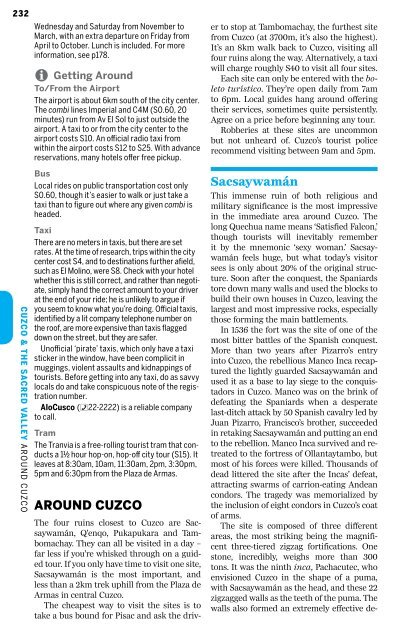peru-8-cuzco-sacred-valley
You also want an ePaper? Increase the reach of your titles
YUMPU automatically turns print PDFs into web optimized ePapers that Google loves.
232<br />
Cuzco & the Sacred Valley 8 A R O U N D C u zC O<br />
Wednesday and Saturday from November to<br />
March, with an extra departure on Friday from<br />
April to October. Lunch is included. For more<br />
information, see p178.<br />
8 Getting Around<br />
To/From the Airport<br />
The airport is about 6km south of the city center.<br />
The combi lines Imperial and C4M (S0.60, 20<br />
minutes) run from Av El Sol to just outside the<br />
airport. A taxi to or from the city center to the<br />
airport costs S10. An official radio taxi from<br />
within the airport costs S12 to S25. With advance<br />
reservations, many hotels offer free pickup.<br />
Bus<br />
Local rides on public transportation cost only<br />
S0.60, though it’s easier to walk or just take a<br />
taxi than to figure out where any given combi is<br />
headed.<br />
Taxi<br />
There are no meters in taxis, but there are set<br />
rates. At the time of research, trips within the city<br />
center cost S4, and to destinations further afield,<br />
such as El Molino, were S8. Check with your hotel<br />
whether this is still correct, and rather than negotiate,<br />
simply hand the correct amount to your driver<br />
at the end of your ride; he is unlikely to argue if<br />
you seem to know what you’re doing. Official taxis,<br />
identified by a lit company telephone number on<br />
the roof, are more expensive than taxis flagged<br />
down on the street, but they are safer.<br />
Unofficial ‘pirate’ taxis, which only have a taxi<br />
sticker in the window, have been complicit in<br />
muggings, violent assaults and kidnappings of<br />
tourists. Before getting into any taxi, do as savvy<br />
locals do and take conspicuous note of the registration<br />
number.<br />
AloCusco (%22-2222) is a reliable company<br />
to call.<br />
Tram<br />
The Tranvia is a free-rolling tourist tram that conducts<br />
a 1½ hour hop-on, hop-off city tour (S15). It<br />
leaves at 8:30am, 10am, 11:30am, 2pm, 3:30pm,<br />
5pm and 6:30pm from the Plaza de Armas.<br />
AROUND CUZCO<br />
The four ruins closest to Cuzco are Sacsaywamán,<br />
Q’enqo, Pukapukara and Tambomachay.<br />
They can all be visited in a day –<br />
far less if you’re whisked through on a guided<br />
tour. If you only have time to visit one site,<br />
Sacsaywamán is the most important, and<br />
less than a 2km trek uphill from the Plaza de<br />
Armas in central Cuzco.<br />
The cheapest way to visit the sites is to<br />
take a bus bound for Pisac and ask the driver<br />
to stop at Tambomachay, the furthest site<br />
from Cuzco (at 3700m, it’s also the highest).<br />
It’s an 8km walk back to Cuzco, visiting all<br />
four ruins along the way. Alternatively, a taxi<br />
will charge roughly S40 to visit all four sites.<br />
Each site can only be entered with the boleto<br />
turístico. They’re open daily from 7am<br />
to 6pm. Local guides hang around offering<br />
their services, sometimes quite persistently.<br />
Agree on a price before beginning any tour.<br />
Robberies at these sites are uncommon<br />
but not unheard of. Cuzco’s tourist police<br />
recommend visiting between 9am and 5pm.<br />
Sacsaywamán<br />
This immense ruin of both religious and<br />
military significance is the most impressive<br />
in the immediate area around Cuzco. The<br />
long Quechua name means ‘Satisfied Falcon,’<br />
though tourists will inevitably remember<br />
it by the mnemonic ‘sexy woman.’ Sacsaywamán<br />
feels huge, but what today’s visitor<br />
sees is only about 20% of the original structure.<br />
Soon after the conquest, the Spaniards<br />
tore down many walls and used the blocks to<br />
build their own houses in Cuzco, leaving the<br />
largest and most impressive rocks, especially<br />
those forming the main battlements.<br />
In 1536 the fort was the site of one of the<br />
most bitter battles of the Spanish conquest.<br />
More than two years after Pizarro’s entry<br />
into Cuzco, the rebellious Manco Inca recaptured<br />
the lightly guarded Sacsaywamán and<br />
used it as a base to lay siege to the conquistadors<br />
in Cuzco. Manco was on the brink of<br />
defeating the Spaniards when a desperate<br />
last-ditch attack by 50 Spanish cavalry led by<br />
Juan Pizarro, Francisco’s brother, succeeded<br />
in retaking Sacsaywamán and putting an end<br />
to the rebellion. Manco Inca survived and retreated<br />
to the fortress of Ollantaytambo, but<br />
most of his forces were killed. Thousands of<br />
dead littered the site after the Incas’ defeat,<br />
attracting swarms of carrion-eating Andean<br />
condors. The tragedy was memorialized by<br />
the inclusion of eight condors in Cuzco’s coat<br />
of arms.<br />
The site is composed of three different<br />
areas, the most striking being the magnificent<br />
three-tiered zigzag fortifications. One<br />
stone, incredibly, weighs more than 300<br />
tons. It was the ninth inca, Pachacutec, who<br />
envisioned Cuzco in the shape of a puma,<br />
with Sacsaywamán as the head, and these 22<br />
zigzagged walls as the teeth of the puma. The<br />
walls also formed an extremely effective de-


